Monti Cabinet
The Monti cabinet was the sixty-first cabinet of the government of Italy and was announced on 16 November 2011.[1][2][3][4] This Experts' cabinet was composed of independents, three of whom were women[5] and was formed as an interim government.[4] The government ran the country for eighteen months until the aftermath of the elections in Spring 2013 and then replaced by the Letta Cabinet, formed by Enrico Letta on 28 April.[6]
| Monti Cabinet | |
|---|---|
61st Cabinet of Italy | |
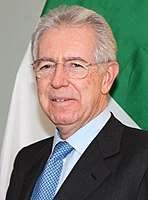 | |
| Date formed | 16 November 2011 |
| Date dissolved | 28 April 2013 (530 days) |
| People and organisations | |
| Head of state | Giorgio Napolitano |
| Head of government | Mario Monti |
| No. of ministers | 18 (incl. Prime Minister) |
| Ministers removed | 1 resigned |
| Total no. of ministers | 19 (incl. Prime Minister) |
| Member parties | Independents External support: PdL, PD, UdC, FLI |
| Status in legislature | National unity government Technocratic cabinet |
| Opposition parties | LN, IdV |
| History | |
| Outgoing election | 2013 election |
| Legislature term(s) | XVI Legislature (2008–2013) |
| Predecessor | Berlusconi IV Cabinet |
| Successor | Letta Cabinet |
Formation
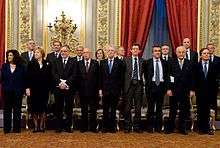
On 9 November 2011, Monti was appointed a Lifetime Senator by Italian President Giorgio Napolitano.[7] He was seen as a favourite to replace Silvio Berlusconi and lead a new unity government in Italy in order to implement reforms and austerity measures.[8] The ultimate purpose of Monti's appointment was to save Italy from the eurozone sovereign debt crisis.[9]
On 12 November 2011, following Berlusconi's resignation, Napolitano asked Monti to form a new government.[10] Monti accepted, and held talks with the leaders of the main Italian political parties, declaring that he wanted to form a government that would remain in office until the next scheduled general elections in 2013.[11] On 16 November 2011, Monti was sworn in as Prime Minister of Italy, after making known a technocratic cabinet composed entirely of unelected professionals.[12] He also chose to hold personally the post of Minister of Economy and Finance.[13][14] His tenure in the latter post lasted until 11 July 2012 when Vittorio Grilli, previously vice-minister, became Minister.[15]
On 17 and 18 November 2011, the Italian Senate and Italian Chamber of Deputies both passed motions of confidence supporting Monti's government, with only Northern League voting against.[16][17]
Investiture votes
Investiture votes for the Monti Cabinet | |||
|---|---|---|---|
| House of Parliament | Vote | Parties | Votes |
| Senate of the Republic[18] (Voting: 306[lower-alpha 1] of 322, Majority: 154) |
PdL (121), PD (104), UDC–SVP–Aut (14), Third Pole (ApI–FLI) (13), IdV (10), CN (10), Others (7) | 281 / 306 | |
| LN (25) | 25 / 306 | ||
| Abstention | None | 0 / 306 | |
| Chamber of Deputies[19] (Voting: 617[lower-alpha 2] of 630, Majority: 309) |
PdL (205), PD (205), UdC (37), FLI (23), PT (22), IdV (21), Others (43) | 556 / 617 | |
| LN (59), PdL (1), PT (1) | 61 / 617 | ||
| Abstention | None | 0 / 617 | |
- Absent (12): PdL (6), PD (2), UDC–SVP–Aut (1), Others (3)
On institutional leave (3): CN (2), Others (1)
President (1) - Absent (12): PdL (6), FLI (3), PD (1), IdV (1), PT (1)
On institutional leave (1): UDC (1)
Composition of the Government
| Portrait | Office | Name | Term | Party | Deputy Ministers Undersecretaries | |
|---|---|---|---|---|---|---|
 |
Prime Minister | Mario Monti | 16 November 2011 – 28 April 2013 | Independent | Undersecretaries: Antonio Catricalà[lower-alpha 1] Paolo Peluffo[lower-alpha 2] Carlo Malinconico[lower-alpha 3] (until 10 January 2012) Gianni De Gennaro[lower-alpha 4] (since 11 May 2012) | |
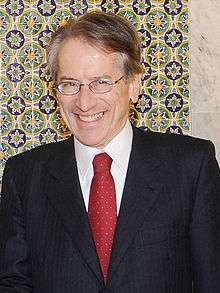 |
Minister of Foreign Affairs | Giulio Terzi di Sant'Agata | 16 November 2011 – 26 March 2013 | Independent | Deputy Ministers: Marta Dassù[lower-alpha 5] (since 27 March 2013) Staffan de Mistura[lower-alpha 5] (since 27 March 2013) | |
 |
Mario Monti (ad interim) |
26 March 2013 – 28 April 2013 | Independent | |||
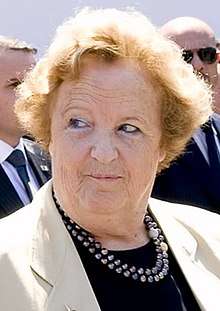 |
Minister of the Interior | Annamaria Cancellieri | 16 November 2011 – 28 April 2013 | Independent | Undersecretaries: Carlo De Stefano Giovanni Ferrara Saverio Ruperto | |
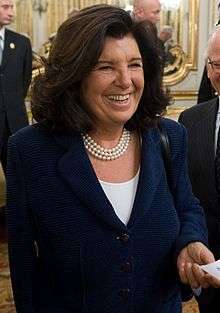 |
Minister of Justice | Paola Severino | 16 November 2011 – 28 April 2013 | Independent | Undersecretaries: Salvatore Mazzamuto Andrea Zoppini (until 15 May 2012) Antonino Gullo (since 6 July 2012) Sabato Malinconico (since 6 July 2012) | |
 |
Minister of Defence | Giampaolo Di Paola | 16 November 2011 – 28 April 2013 | Independent | Undersecretaries: Filippo Milone Gianluigi Magri | |
 |
Minister of Economy and Finance | Mario Monti (ad interim) |
16 November 2011 – 11 July 2012 | Independent | Deputy Ministers: Vittorio Grilli (until 11 July 2012) Undersecretaries: Vieri Ceriani Gianfranco Polillo | |
 |
Vittorio Grilli | 11 July 2012 – 28 April 2013 | Independent | |||
 |
Minister of Economic Development | Corrado Passera | 16 November 2011 – 28 April 2013 | Independent | Undersecretaries: Claudio De Vincenti Massimo Vari | |
| Minister of Infrastructure and Transport | Deputy Ministers: Mario Ciaccia Undersecretaries: Guido Improta | |||||
| Minister of Agricultural, Food and Forestry Policies | Mario Catania | 16 November 2011 – 28 April 2013 | Independent | Undersecretaries: Franco Braga | ||
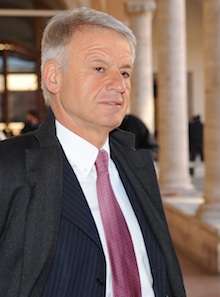 |
Minister of the Environment | Corrado Clini | 16 November 2011 – 28 April 2013 | Independent | Undersecretaries: Tullio Fanelli | |
| Minister of Labour and Social Policies | Elsa Fornero | 16 November 2011 – 28 April 2013 | Independent | Deputy Ministers: Michel Martone Undersecretaries: Maria Cecilia Guerra | ||
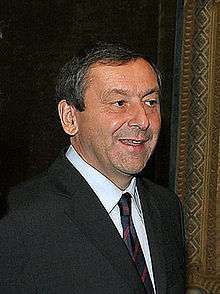 |
Minister of Education, University and Research | Francesco Profumo | 16 November 2011 – 28 April 2013 | Independent | Undersecretaries: Elena Ugolini Marco Rossi-Doria | |
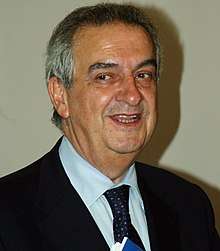 |
Minister of Cultural Heritage and Activities | Lorenzo Ornaghi | 16 November 2011 – 28 April 2013 | Independent | Undersecretaries: Roberto Cecchi | |
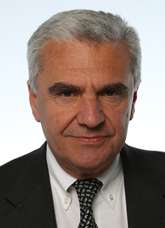 |
Minister of Health | Renato Balduzzi | 16 November 2011 – 28 April 2013 | Independent | Undersecretaries: Adelfio Elio Cardinale | |
_cropped.jpg) |
Minister of European Affairs (without portfolio) |
Enzo Moavero Milanesi | 16 November 2011 – 28 April 2013 | Independent | ||
 |
Minister of Regional Affairs, Tourism and Sport (without portfolio) |
Piero Gnudi | 16 November 2011 – 28 April 2013 | Independent | ||
.jpg) |
Minister of Territorial Cohesion (without portfolio) |
Fabrizio Barca | 16 November 2011 – 28 April 2013 | Independent | ||
| Minister for Parliamentary Relations and Implementation of the Government Program (without portfolio) |
Dino Piero Giarda | 16 November 2011 – 28 April 2013 | Independent | Undersecretaries: Giampaolo D'Andrea Antonio Malaschini | ||
.jpg) |
Minister for Integration and International Cooperation (without portfolio) |
Andrea Riccardi | 16 November 2011 – 28 April 2013 | Independent | ||
 |
Minister of Public Administration (without portfolio) |
Filippo Patroni Griffi | 16 November 2011 – 28 April 2013 | Independent | ||
| Independent | — | |||||
- With delegation to administrative coordination (until 19 January 2012)
- With delegation to information and communications, publishing, and administrative coordination (since 19 January 2012)
- With delegation to publishing.
- Delegated authority for the security of the Republic.
- Undersecretary until 27 March 2013
Notable actions
On 9 October 2012, Interior Minister Anna Maria Cancellieri sacked the municipal administration of Reggio Calabria (mayor, assessors, councillors) for alleged links to the organised crime syndicate 'Ndrangheta after a months long investigation and replaced it with three central government appointed administrators to govern for 18 months until a new election in 2014. This was the first time the government of a provincial capital had been dismissed.[20]
References
- "Mario Monti's technocrats: profiles of the new Italian cabinet". The Guardian. 16 November 2011. Retrieved 16 November 2011.
- "Monti unveils technocratic cabinet for Italy". BBC News. 16 November 2011. Retrieved 16 November 2011.
- "Facing Crisis, Technocrats Take Charge in Italy". The New York Times. 16 November 2011. Retrieved 16 November 2011.
- Marangoni, Francesco (2012). "Technocrats in Government: The Composition and Legislative Initiatives of the Monti Government Eight Months into its Term of Office" (PDF). Bulletin of Italian Politics. 4 (1): 135–149. Retrieved 9 September 2012.
- "Monti's Team – Seven Academics, Three Women and No Politicos". Corriere della Sera. 16 November 2011. Retrieved 16 November 2011.
- Dinmore, Guy (28 April 2013). "Mayhem greets Italy's grand coalition". Financial Times. Rome. Retrieved 29 April 2013.
- "Napolitano nomina Monti senatore a vita". Corriere della Sera. 9 November 2011. Retrieved 9 November 2011.
- Vagnoni, Giselda; Hornby, Catherine (10 November 2011). "Mario Monti Emerges as Favorite To Lead Italy". Reuters. Retrieved 10 November 2011.
- "Italy: Minister calls for fighting corruption". The Independent. AP. 10 September 2012. Retrieved 15 September 2012.
- "Incarico a Monti: "Occorre crescita ed equità"". la Repubblica. 12 November 2011. Retrieved 12 November 2011.
- Donadio, Rachel; Povoledo, Elisabetta (16 November 2011). "Facing Crisis, Technocrats Take Charge in Italy". The New York Times. Retrieved 16 November 2011.
- "Monti Unveils Technocratic Cabinet for Italy" (16 November 2011). BBC News. Retrieved 17 November 2011.
- Squires, Nick (16 November 2011). "Mario Monti Appoints Himself Economy Minister as He Unveils Italy Government". The Daily Telegraph. Retrieved 16 November 2011.
- "Monti Unveils Technocratic Cabinet for Italy". BBC News. 16 November 2011. Retrieved 17 November 2011.
- "Vittorio Grilli to replace Mario Monti as Italy's new finance minister: Government". The Economic Times. Rome. 11 July 2012. Retrieved 4 September 2012.
- Winfield, Nicole (18 November 2011). "Italian leader Mario Monti wins second confidence vote". The Independent. Retrieved 10 February 2012.
- "New Italy PM wins confidence vote on tough reform plans". Reuters. 17 November 2011. Retrieved 13 February 2012.
- "Legislatura 16ª - Aula - Resoconto stenografico della seduta n. 637 del 17/11/2011". www.senato.it (in Italian). Retrieved 3 August 2019.
- "Resoconto stenografico dell'Assemblea – Seduta n. 551 di venerdì 18 novembre 2011". leg16.camera.it (in Italian). Retrieved 3 August 2019.
- "Italy sacks city government over mafia links". Al Jazeera. 4 October 2011. Retrieved 11 October 2012.
